
Operation Ivy was the eighth series of American nuclear tests, coming after Tumbler-Snapper and before Upshot–Knothole. The two explosions were staged in late 1952 at Enewetak Atoll in the Pacific Proving Ground in the Marshall Islands.

The Republic F-84 Thunderjet was an American turbojet fighter-bomber aircraft. Originating as a 1944 United States Army Air Forces (USAAF) proposal for a "day fighter", the F-84 first flew in 1946. Although it entered service in 1947, the Thunderjet was plagued by so many structural and engine problems that a 1948 U.S. Air Force review declared it unable to execute any aspect of its intended mission and considered canceling the program. The aircraft was not considered fully operational until the 1949 F-84D model and the design matured only with the definitive F-84G introduced in 1951. In 1954, the straight-wing Thunderjet was joined by the swept-wing F-84F Thunderstreak fighter and RF-84F Thunderflash photo reconnaissance aircraft.

The WC-135 Constant Phoenix is a special-purpose aircraft derived from the Boeing C-135 Stratolifter and used by the United States Air Force. Its mission is to collect samples from the atmosphere for the purpose of detecting and identifying nuclear explosions. It is also informally referred to as the "weather bird" or "the sniffer" by workers on the program and international media respectively.

The Martin B-57 Canberra is an American-built, twin-engined tactical bomber and reconnaissance aircraft that entered service with the United States Air Force (USAF) in 1953. The B-57 is a license-built version of the British English Electric Canberra, manufactured by the Glenn L. Martin Company. Initial Martin-built models were virtually identical to their British-built twinjet counterparts; Martin later modified the design to incorporate larger quantities of US-sourced components and produced the aircraft in several variants.

Kirtland Air Force Base is a United States Air Force base. It is located in the southeast quadrant of the Albuquerque, New Mexico, urban area, adjacent to the Albuquerque International Sunport. The base was named for the early Army aviator Col. Roy C. Kirtland. The military and the international airport share the same runways, making ABQ a joint civil-military airport.
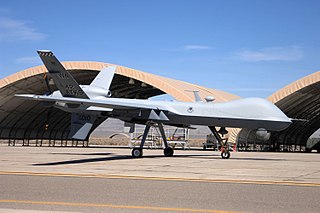
Creech Air Force Base is a United States Air Force (USAF) command and control facility in Clark County, Nevada used "to engage in daily Overseas Contingency Operations …of remotely piloted aircraft systems which fly missions across the globe." In addition to an airport, the military installation has the Unmanned Aerial Vehicle Battlelab, associated aerial warfare ground equipment, and unmanned aerial vehicles of the type used in Afghanistan and Iraq. Creech is the aerial training site for the USAF Thunderbirds and "is one of two emergency divert airfields" for the Nevada Test and Training Range.

The Air Force Nuclear Weapons Center (AFNWC) is a USAF Named Unit, assigned to the Air Force Materiel Command at Kirtland Air Force Base, New Mexico. The AFNWC operates at the Center level of the AFMC. It is currently under the command of Major General John P. Newberry.

The 58th Reconnaissance Squadron is an inactive United States Air Force squadron. Its last was assigned to the 9th Weather Reconnaissance Wing at Kirtland Air Force Base, New Mexico, where it was inactivated in 1974.

The 57th Weather Reconnaissance Squadron is an inactive United States Air Force squadron. Its last assignment was with the 9th Weather Reconnaissance Wing at Hickam Air Force Base, Hawaii, where it was inactivated on 10 November 1969.
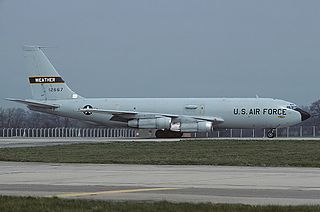
The 55th Space Weather Squadron is an inactive United States Air Force unit. It was last assigned to the 50th Operations Group at Schriever Air Force Base, Colorado, where it was inactivated on 16 July 2002.

The 4080th Strategic Reconnaissance Wing is a discontinued United States Air Force (USAF) wing last assigned to the 12th Strategic Aerospace Division of Strategic Air Command (SAC) at Davis–Monthan AFB, Arizona. It was SAC's high altitude reconnaissance wing for its existence and was the first USAF wing to operate the Lockheed U-2. It was discontinued as part of a program to replace operational units controlled by major commands with those controlled by USAF whose lineages could be continued.

The Martin/General Dynamics RB-57F Canberra is a specialized strategic reconnaissance aircraft developed in the 1960s for the United States Air Force by General Dynamics from the Martin B-57 Canberra tactical bomber, which itself was a license-built version of the English Electric Canberra. It was operationally assigned to the Air Weather Service for weather reconnaissance involving high-altitude atmospheric sampling and radiation detection in support of nuclear test monitoring, but four of the 21 modified aircraft performed solely as strategic reconnaissance platforms in Japan and Germany.

The Martin RB-57D Canberra was a specialized high-altitude strategic reconnaissance aircraft developed from the Martin B-57 Canberra tactical bomber, a license-built version of the English Electric Canberra. It was used by the United States Air Force during the 1950s prior to operational use of the Lockheed U-2.
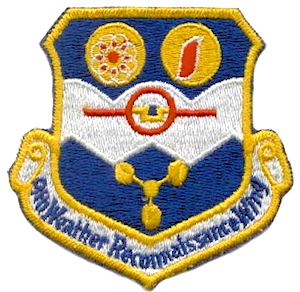
The 9th Weather Reconnaissance Wing is an inactive United States Air Force organization. Its last assignment was with Air Weather Service at McClellan Air Force Base, California, where it was inactivated on 31 August 1975.

The 6091st Reconnaissance Squadron is an inactive United States Air Force unit. Its last was assigned to the 41st Air Division, stationed at Yokota Air Base, Japan. It was inactivated on 1 July 1968.

The 4925th Test Group is a discontinued United States Air Force unit. It was last assigned to the 4901st Support Wing (Atomic), at Kirtland Air Force Base, New Mexico, where it was discontinued on 31 August 1961. Known as "The Megaton Blasters", the 4925th was responsible for the development flight testing of all USAF nuclear weapon delivery systems including conducting live test drops from 1951 though 1956. Following 1956 the group focused on operational methods and equipment for delivering nuclear weapons. It was discontinued when Air Force Systems Command replaced Air Research and Development Command and components of its mission were distributed among other units.
The 4950th Test Group (Nuclear) is an inactive United States Air Force unit. It was last was assigned to Air Force Special Weapons Center, stationed at Kirtland AFB, New Mexico. It was inactivated on 16 August 1961.
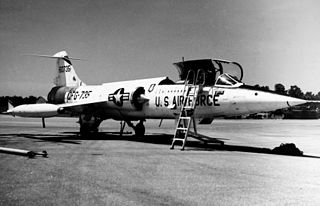
The 3205th Drone Squadron is a discontinued United States Air Force unit. It was last active with the Air Proving Ground Center based at Eglin Air Force Base, Florida, where it was discontinued on 25 October 1963. The squadron operated various drones between 1950 and 1963 to provide targets to support development of weapons and for interceptor training.
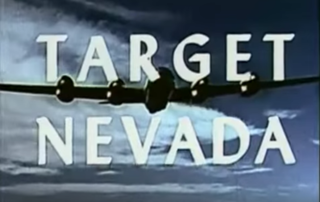
Target Nevada Special Film Project (S.F.P.) 281 (1951) is an instructional documentary short film produced by United States Air Force (USAF). The film documents the story of the USAF support to the United States Atomic Energy Commission for 1949–1951 continental atom bomb tests. In an era of postwar "atomic scare" films, Target Nevada is a straightforward documentary film on nuclear weapons testing.




















